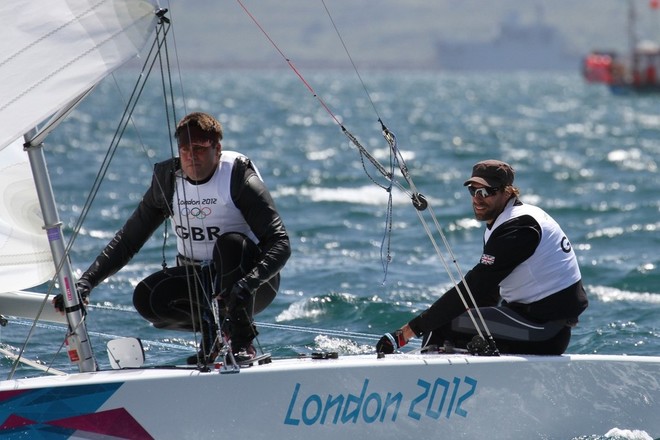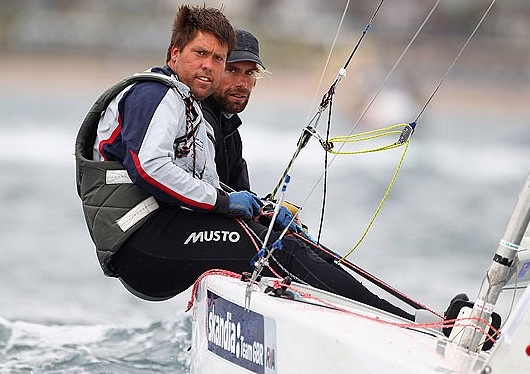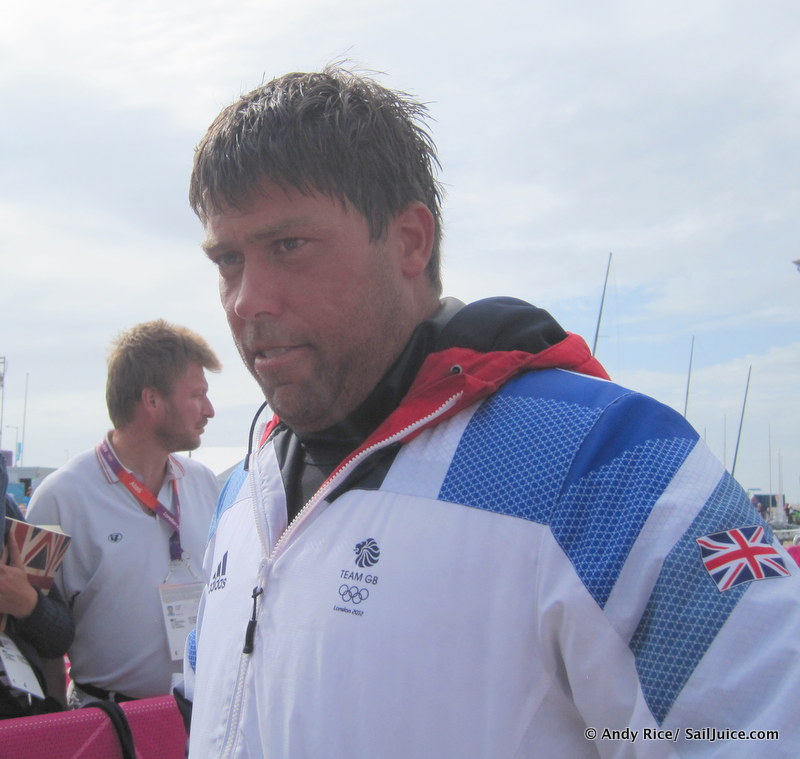Roll Tacks - September 2014
Well, it happened! Bart’s Bash was all that anyone could have hoped for, and so much more.
Sunday 21st September 2014 was one of those ‘where were you?’ moments. I was expecting to race my Musto Skiff at my home club of Stokes Bay, until a late call to come and help out with the live internet broadcast from Weymouth and Portland Sailing Academy, which is also now the site of the Andrew Simpson Sailing School, one of the first concrete achievements of the fledgling Andrew Simpson Sailing Foundation. Working with Simon Walton and his crew from Silverstream, with their space-age satellite truck, I would be live broadcasting from 9am to 7pm, trying to make sense of all the tweets, YouTube videos and other messages flowing in from around the world. And I would be presenting alongside Miss England 2012, Miss Charlotte Holmes. What’s not to like!
But I really wanted to do the race too, to be a Guinness World Record holder. So, the matter of borrowing a boat. Tim Anderton, event manager for Bart’s Bash already with a million and one things to do, was kind enough to sort me out with a Topper, the boat I learned to sail in and which I hadn’t raced for 30 years. Perfect! Having had dinner the previous evening with Helena Darvelid and Paul Larsen, the couple behind the world-record-breaking SailRocket project, I convinced Paul to get out in a Topper too. He took the boat for the first race of the day, the fastest man in the world racing in one of the slowest boats, against the likes of Paul Goodison in his Moth and Paul Campbell-James and Nick Hutton racing the Ben Ainslie Racing foiling Nacra 20. I think Paul was a little sceptical about sailing something quite as basic as a Topper, but I also think he secretly enjoyed himself more than he expected.
Quite apart from the rock stars that turned out to participate in Bart’s Bash, not only in Weymouth but in Santander at the ISAF World Championships and at the TP52 regatta in Palma and many other global locations, the most thrilling aspect of the event was the number of first-time sailors that were enticed to go on the water. Freddie Simpson, Bart’s four-year-old son, had the sail of his life aboard the London 2012 Star that his father had raced two years earlier on the very same waters. Freddie was sitting between Iain Percy and Anthony ‘Nocka’ Nossiter, one of Bart’s best mates who had flown over from San Francisco for the occasion. But I’ll bet Freddie wasn’t the youngest to go sailing on that day, although I do wonder if there was anyone older than the 94-year-old that I heard went out on Portland Harbour.
As a sport, we’ve been very good at dividing ourselves into different categories, segmenting ourselves into smaller and smaller groups. Bart’s Bash was about being inclusive, about getting bums on boats, whatever the age, shape, size or experience of the bum. I think a lot of people just enjoyed the experience of getting out on the water, of remembering why we all started sailing, for the sheer pleasure of mucking about in boats. The serious racing comes later. It’s good to be reminded that racing isn’t the be-all-and-end-all.
As I write, it’s only a few days after Bart’s Bash, so Tim Anderton and his crew are still busy making sense of the results that have been flowing in from around the world. There is a lot of analysis and cross-checking to be done when putting together a new system like this. Creating a Bart Number, a handicap number for each of the 2300-plus different types of boat that signed up to take part - along with a number of UFOs (unidentified floating objects) - was no small undertaking. Behind the scenes, the RYA’s Bas Edmonds and Debbi Smith deserve a lot of credit for working out a sensible number for so many types of boat, both well known and virtually unknown.
With Bart’s Bash, Jez Payne, Tony Bishop and the rest of their great team have changed the landscape. The inaugural event was just the start of what I hope will go towards creating a viable global handicapping system that will develop into something really sustainable and meaningful for the sailing world. Bart’s Bash helped many sailing clubs around the UK, and the wider world, to attract some of their best Sunday turnouts in years. Of course, a lot of that record turnout can be attributed to people wanting to sail in Bart’s honour. But an even greater tribute to the big man would be for the Bart Number to become a common currency for Sunday club racing. Local events, globally connected. What a great legacy that would be to the memory of Bart.
Sunday 21st September 2014 was one of those ‘where were you?’ moments. I was expecting to race my Musto Skiff at my home club of Stokes Bay, until a late call to come and help out with the live internet broadcast from Weymouth and Portland Sailing Academy, which is also now the site of the Andrew Simpson Sailing School, one of the first concrete achievements of the fledgling Andrew Simpson Sailing Foundation. Working with Simon Walton and his crew from Silverstream, with their space-age satellite truck, I would be live broadcasting from 9am to 7pm, trying to make sense of all the tweets, YouTube videos and other messages flowing in from around the world. And I would be presenting alongside Miss England 2012, Miss Charlotte Holmes. What’s not to like!
But I really wanted to do the race too, to be a Guinness World Record holder. So, the matter of borrowing a boat. Tim Anderton, event manager for Bart’s Bash already with a million and one things to do, was kind enough to sort me out with a Topper, the boat I learned to sail in and which I hadn’t raced for 30 years. Perfect! Having had dinner the previous evening with Helena Darvelid and Paul Larsen, the couple behind the world-record-breaking SailRocket project, I convinced Paul to get out in a Topper too. He took the boat for the first race of the day, the fastest man in the world racing in one of the slowest boats, against the likes of Paul Goodison in his Moth and Paul Campbell-James and Nick Hutton racing the Ben Ainslie Racing foiling Nacra 20. I think Paul was a little sceptical about sailing something quite as basic as a Topper, but I also think he secretly enjoyed himself more than he expected.
Quite apart from the rock stars that turned out to participate in Bart’s Bash, not only in Weymouth but in Santander at the ISAF World Championships and at the TP52 regatta in Palma and many other global locations, the most thrilling aspect of the event was the number of first-time sailors that were enticed to go on the water. Freddie Simpson, Bart’s four-year-old son, had the sail of his life aboard the London 2012 Star that his father had raced two years earlier on the very same waters. Freddie was sitting between Iain Percy and Anthony ‘Nocka’ Nossiter, one of Bart’s best mates who had flown over from San Francisco for the occasion. But I’ll bet Freddie wasn’t the youngest to go sailing on that day, although I do wonder if there was anyone older than the 94-year-old that I heard went out on Portland Harbour.
As a sport, we’ve been very good at dividing ourselves into different categories, segmenting ourselves into smaller and smaller groups. Bart’s Bash was about being inclusive, about getting bums on boats, whatever the age, shape, size or experience of the bum. I think a lot of people just enjoyed the experience of getting out on the water, of remembering why we all started sailing, for the sheer pleasure of mucking about in boats. The serious racing comes later. It’s good to be reminded that racing isn’t the be-all-and-end-all.
As I write, it’s only a few days after Bart’s Bash, so Tim Anderton and his crew are still busy making sense of the results that have been flowing in from around the world. There is a lot of analysis and cross-checking to be done when putting together a new system like this. Creating a Bart Number, a handicap number for each of the 2300-plus different types of boat that signed up to take part - along with a number of UFOs (unidentified floating objects) - was no small undertaking. Behind the scenes, the RYA’s Bas Edmonds and Debbi Smith deserve a lot of credit for working out a sensible number for so many types of boat, both well known and virtually unknown.
With Bart’s Bash, Jez Payne, Tony Bishop and the rest of their great team have changed the landscape. The inaugural event was just the start of what I hope will go towards creating a viable global handicapping system that will develop into something really sustainable and meaningful for the sailing world. Bart’s Bash helped many sailing clubs around the UK, and the wider world, to attract some of their best Sunday turnouts in years. Of course, a lot of that record turnout can be attributed to people wanting to sail in Bart’s honour. But an even greater tribute to the big man would be for the Bart Number to become a common currency for Sunday club racing. Local events, globally connected. What a great legacy that would be to the memory of Bart.
Related Articles

Roll Tacks - January 2014
About a year ago I used this column to put out a madcapped theory about holding a virtual Sunday morning race. “Pretty much every club in the country has a race on a Sunday morning, with all kinds of boat taking part. Race results are captured electronically on software packages such as Sailwave and Excel. So why can’t the results from different sailing clubs be mashed together to create one big nationwide race on a Sunday morning? A weekly handicap racing championship!”
Read More

Bart Simpson Interview - Part 2
Read More

By the end of 2002, Bart’s sailing and his results had gone downhill. “I ended up trying to beat Ben rather than trying to sail my best.” He took himself to a psychologist. “I wasn’t thinking the right things. He taught me to refocus on sailing the best you can rather than trying to beat anyone else. He helped get my brain back on track, and I made some steps forwards, focusing on improving my own performance rather than worrying about anyone else.”

Bart Simpson Interview - Part 1
Read More

Could there be any reason to believe that a team that had just finished 52nd in the Star World Championships had any hope of winning a medal at the Olympic Games later in the year? On the face of it that question seems like a no-brainer. How could any team have serious designs on a top three at the Games, let along winning gold? But if you know that the team in question is Iain Percy and Andrew Simpson, and you know anything of what these sailors have achieved, then you might change your view.

Ben Ainslie & Iain Percy remember their friend Andrew 'Bart' Simpson
 Speaking at Weymouth in May 2014, Iain Percy and Sir Ben Ainslie remember their great friend, Bart Simpson, as they launch the Andrew Simpson Sailing Foundation and its first school at the venue of London 2012, where Bart won the second of his two Olympic medals....
Speaking at Weymouth in May 2014, Iain Percy and Sir Ben Ainslie remember their great friend, Bart Simpson, as they launch the Andrew Simpson Sailing Foundation and its first school at the venue of London 2012, where Bart won the second of his two Olympic medals....
Read More

Roll Tacks - June 2013
Great to see Luke Patience and Stu Bithell throwing themselves into the Wilson Trophy, the sort of unofficial world championship of team racing. We don’t often see the Olympic stars get involved in the nitty gritty of the amateur dinghy racing scene, and who can blame them? Must be a bit of a busman’s holiday, going sailing in your spare time. So it’s nice to see it when it does happen, like Paul Goodison and Saskia Clark doing a bit of Essex dinghy racing last summer just weeks after London 2012, and now Luke and Stu getting stuck into team racing.
Read More
